Much has been written and said about the January 29, 2025 Washington, D.C. mid-air collision between American Eagle Flight 5342, a Bombardier CRJ 700 aircraft operated by PSA Airlines, and a U.S. Army UH-60 helicopter. The crash killed all 60 passengers aboard AA 5342, along with the 4 crew members, and the 3 people in the helicopter.
At the time of the crash, AA 5342 was on final approach for landing to the north-northwest on Runway 33, and the Army helicopter was flying in a westerly direction along the Potomac River on the right-hand side of AA 5342.
The narrative so far has focused on the roles of the FAA, Air Traffic Control, the Army and the helicopter flight crew. While such criticisms are valid, there is another critical aspect to this crash that has not been discussed – the role of the AA5342 flight crew. A deep dive into the evidence shows that the AA5342 flight crew contributed significantly to this tragedy.
AA 5342 departed Wichita, Kansas around 5:39 P.M. local time (6:39 P.M. EST). The enroute portion of the flight was largely uneventful. Both crew members were experienced flying into DCA, but experience, while valuable, can also lead to a false sense of confidence.
At 8:07 P.M. EST, Indianapolis Center instructed AA 5342 to contact Washington Center. Centers are responsible for monitoring air traffic at high altitudes.
A short time later, the crew discussed whether they would be assigned the Mount Vernon Visual Approach to Runway 1 or the ILS (“Instrument Landing System”) Approach to Runway 1. These are two different approaches to the same runway. The captain (“Hot 1” in the cockpit voice recorder transcript – “Hot 2” is the First Officer) then stated that the approach would be the Mount Vernon Visual backed up by the ILS Approach to Runway 1.
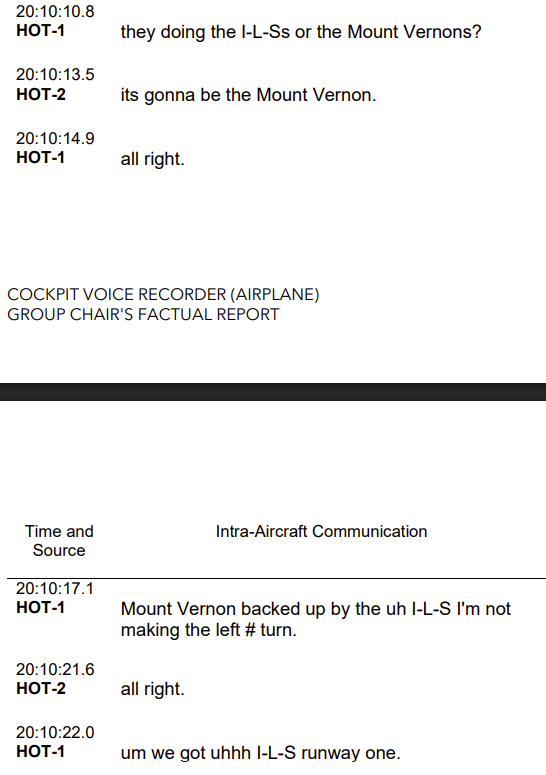
The captain then ran through a quick brief of the ILS Approach to Runway 1. The total brief time was 33 seconds. The transcript portion below contains the entire approach brief.
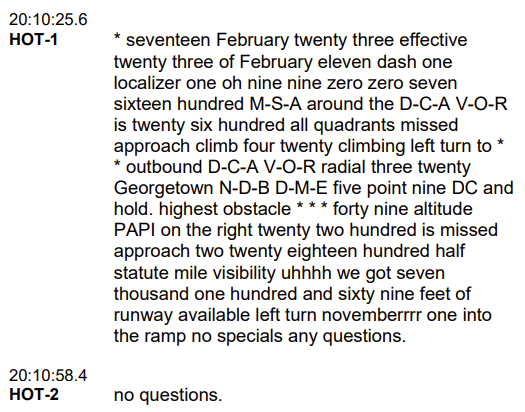
The ILS Runway 1 Approach is shown below on the left. The Mount Vernon Visual is in the middle. The circling approach to Runway 33 is on the right.
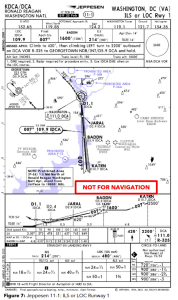
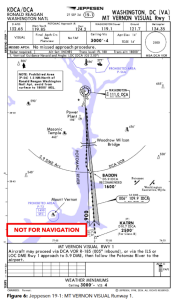
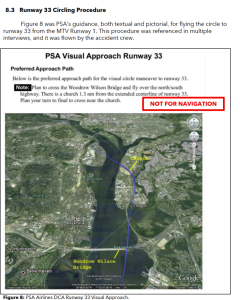
It is important to note that the flight crew of AA 5342 did not brief the Mount Vernon Visual Approach to Runway 1 at DCA (the middle one above), nor did they brief the approach to Runway 33 (on the right above). They only briefed the approach on the left above. The Mount Vernon Visual Approach to Runway 1 (middle), however, was the primary approach used, and the ILS Runway 1 approach (left) was generally only a backup.
With that in mind, the following graphic is from PSA Airlines. This document provides critical company information to PSA pilots on how to set up and prepare for landing on Mount Vernon Visual Approach to Runway 1 at DCA.

A couple of points are of particular importance from the PSA Airlines document.
The PSA document instructs pilots to brief both the ILS and the Mount Vernon Visual Approaches to Runway 1 at DCA. (see paragraph 1 in the graphic above, under Flight Deck Setup). The flight crew of AA 5342 did not do this. The crew only briefed the ILS 1 approach.
The PSA document also instructs flight crews to consider briefing the approach to Runway 33 and to not accept changes in approach or landing runway unless the approach for that runway has been briefed ahead of time. (see paragraph 2 under Flight Deck Setup). Again, the AA 5342 flight crew did not brief the approach or landing to Runway 33 at DCA, nor did they discuss the conditions under which a change to Runway 33 would be accepted.
Nonetheless, at 8:26 P.M. EST, Washington Center instructed AA 5342 to contact DCA approach. At 8:39 P.M. EST, DCA approach contacted AA 5342 and told them they were cleared for the Mount Vernon Visual Runway 1 approach – which is an approach that the flight crew for AA 5342 had not briefed. (Recall the crew only briefed the ILS Runway 1 Approach).
At 8:42 P.M. EST, AA 5342 was instructed to contact DCA tower. AA 5342 contacted the DCA Tower as instructed, but had still not briefed the Mount Vernon Visual Approach to Runway 1.
Immediately upon contacting the DCA Tower, AA 5342 was asked if it would accept landing on Runway 33 – yet another approach that the crew had not briefed. (TWR-A is DCA Tower).

The AA 5342 flight crew then had a brief discussion, in which the captain expressed reluctance, but ultimately agreed to accept the approach and runway change. (Hot 1 is the Captain and Hot 2 is the First Officer).

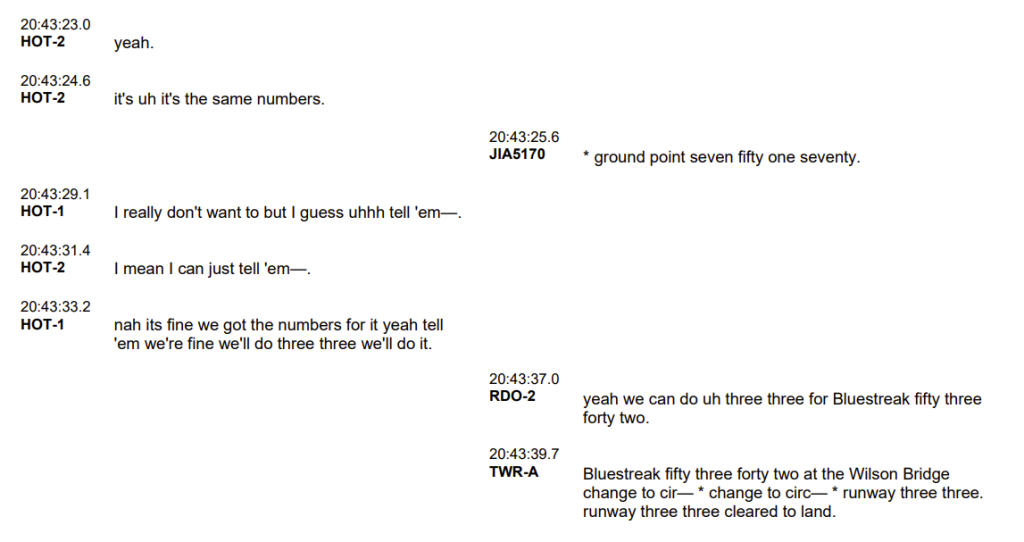
The last two transmissions above are the AA5342 crew (RDO-2) telling the DCA Tower (TWR-A) that they will accept the circling approach to Runway 33, and the Tower clearing them for that approach.
A very important thing to note is that the aircraft arriving immediately prior to AA 5342, which was another PSA / American Eagle / American CRJ 700 aircraft, was asked if it would accept Runway 33, and the captain of that aircraft said no. That flight was then cleared to land on Runway 1 and did so without consequence or incident. In an interview with the NTSB after the accident, the captain of that flight said he declined because he and his first officer discussed Runway 33 ahead of time and the first officer, who was flying that approach, did not want to do it. In contrast, based on the evidence we see, the AA5342 crew never discussed taking Runway 33 but took it anyway, in violation of the above PSA document.
Nonetheless, by accepting the runway change to 33, the crew of AA 5342 significantly increased their cockpit workload and began deleting all of the previous navigational inputs they had set for the approach to Runway 1. (Hot 1 is the Captain of AA5342, Hot 2 is the First Officer).

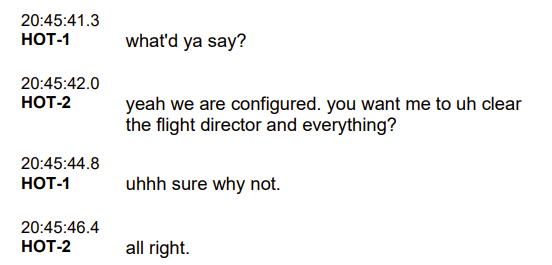
The AA 5342 flight crew then began their landing checklist, while simultaneously searching for approach information on Runway 33.

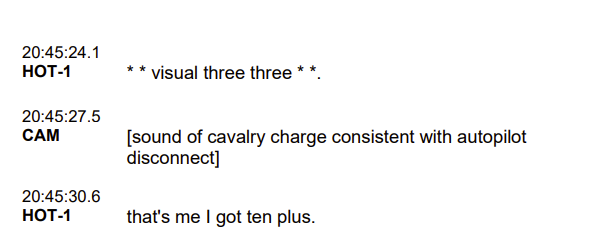
The AA 5342 flight crew continued to be preoccupied and overloaded with reconfiguring the cockpit, with their last-minute landing checks and with working to catch up on procedures for circling to Runway 33, which again, was not previously briefed.
At 8:47 and 39 seconds EST, DCA Tower (TWR-A) called the Army helicopter involved in this crash (“PAT two five”) and asked if the helicopter had the CRJ in sight.

One second later, the Traffic Collision Avoidance System (“TCAS”) in the cockpit of AA 5342 provided a traffic advisory, with an automated voice stating, “traffic, traffic.” (see above 20:47:40.3).
There is no indication from the cockpit voice recorder that the overloaded flight crew of AA 5342 received, acknowledged or otherwise responded to the TCAS traffic warning.
The mid-air collision occurred eighteen seconds later.
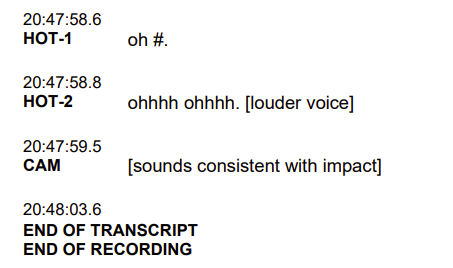
Eighteen seconds is more than enough time for the AA 5342 flight crew to have taken some action to avoid this collision. In accepting the circling approach to Runway 33, however, the crew put themselves in a position where they were overloaded and “heads down” in the cockpit trying to catch up. They were not prepared to take Runway 33, had not pre-briefed it as their own company policy instructed, and were scrambling at the last minute to make the necessary changes. This likely caused them to ignore or de-prioritize the TCAS traffic warning about the approaching helicopter. Based on the cockpit voice recorder transcript, it does not appear that either the Captain or the First Officer even looked out the cockpit window; nor did they ask Air Traffic Control about the location of the traffic.
Had the crew of AA5342 simply followed their own company guidance and declined Runway 33 because they had not pre-briefed it, the plane would have landed on Runway 1 and the accident would not have happened. Instead, the flight crew put themselves behind the cockpit and placed themselves into a zone of negligence that was simultaneously being created, and had previously been created, by the Army, the FAA, the Army helicopter crew and Air Traffic Control.
Many failures caused this tragedy, but a quick focus on the AA5342 flight crew shows that their poor decision making, including ignoring their own company policy, was a significant factor.